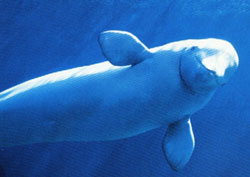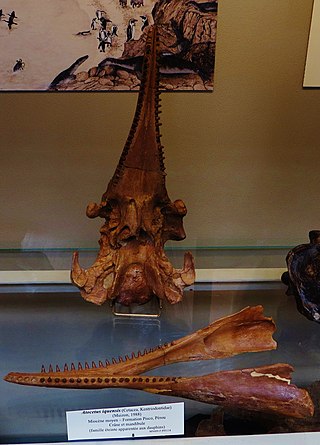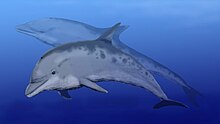
Lipotidae is a family of river dolphins containing the possibly extinct baiji of China and the fossil genus Parapontoporia from the Late Miocene and Pliocene of the Pacific coast of North America. The genus Prolipotes, which is based on a mandible fragment from Neogene coastal deposits in Guangxi, China, has been classified as an extinct relative of the baiji, but is dubious. The oldest known member of the family is Eolipotes from the Late Miocene of Japan.

The cetacean family Monodontidae comprises two living whale species, the narwhal and the beluga whale and at least four extinct species, known from the fossil record. Beluga and Narwhal are native to coastal regions and pack ice around the Arctic Ocean. Both species are relatively small whales, 3–5 m (9.8–16.4 ft) in length, with a forehead melon, and a short or absent snout. Premaxillary teeth are absent. They do not have a true dorsal fin, but do have a narrow ridge running along the back, which is much more pronounced in the narwhal. They are highly vocal animals, communicating with a wide range of sounds. Like other whales, they also use echolocation to navigate. Belugas can be found in the far north of the Atlantic and Pacific Oceans; the distribution of narwhals is restricted to the Arctic and Atlantic Oceans.

Squalodon is an extinct genus of whales of the Oligocene and Miocene epochs, belonging to the family Squalodontidae. Named by Jean-Pierre Sylvestre de Grateloup in 1840, it was originally believed to be an iguanodontid dinosaur but has since been reclassified. The name Squalodon comes from Squalus, a genus of shark. As a result, its name means "shark tooth". Its closest modern relative is the South Asian river dolphin.

Brygmophyseter, known as the biting sperm whale, is an extinct genus of toothed whale in the sperm whale family with one species, B. shigensis. When it was first described in 1994, the species was placed in the genus Scaldicetus based on tooth morphology, but this was later revised in 1995. In 2006, it was classified into the genus Naganocetus, which is considered to be a junior synonym. The only known specimen, a nearly complete skeleton, was dated to be around 16–15 million years old. Brygmophyseter is thought to have been 6.5–7 meters (21–23 ft) long, and it probably had 11 or 12 teeth in the upper and lower jaws. Brygmophyseter is part of a group of macroraptorial sperm whales which tended to be apex predators using their large teeth to catch struggling prey such as whales. It had a spermaceti organ which was probably used for biosonar like in the modern sperm whale. The whale has made an appearance on The History Channel's TV series Jurassic Fight Club.

Kentriodontidae is an extinct family of odontocete whales related to modern dolphins. The Kentriodontidae lived from the Oligocene to the Pliocene before going extinct.

Delphinoidea is the largest group of toothed whales, including 66 genera in 6 families. The largest living member of the superfamily is the killer whale, which can reach 6 tons, while the smallest is the vaquita.

Scaldicetus is an extinct genus of highly predatory macroraptorial sperm whale. Although widely used for a number of extinct physeterids with primitive dental morphology consisting of enameled teeth, Scaldicetus as generally recognized appears to be a wastebasket taxon filled with more-or-less unrelated primitive sperm whales.
The Astoria Formation is a geologic formation in Washington state & Oregon. It preserves fossils dating back to the early to middle Miocene.

Atocetus is an extinct genus of pontoporiid dolphin found in Miocene-age marine deposits in Peru and California.
Zarhinocetus is an extinct genus of whale from the Early to Middle Miocene of the eastern North Pacific.
Macrokentriodon is an extinct genus of giant dolphin once assigned to the paraphyletic/polyphyletic family Kentriodontidae. Remains have been found in the late Miocene (Serravallian) Choptank Formation of United States.
Notocetus is an extinct genus of river dolphin belonging to Squalodelphinidae. Known specimens have been found in Early Miocene marine deposits from Argentina, Italy and Peru.
Liolithax is an extinct genus of dolphin from the Middle Miocene (Serravallian) Temblor Formation of California.

Lophocetus is an extinct genus of dolphin belonging to the clade Delphinida that is known from late Miocene (Tortonian) marine deposits in California and Maryland. Although usually placed in Kentriodontidae, recent studies have found it only distantly related to Kentriodon.
Eodelphinus is an extinct genus of oceanic dolphins belonging to the family Delphinidae.

Idiorophus is a genus of extinct toothed whales in the family Physeteridae. Fossils have been found in the Colhuehuapian Gaiman Formation of Argentina and the Libano Sandstone in Italy.
Eudelphis is an extinct genus of sperm whale belonging to Physeteroidea that lived in the ancient North Sea basin about 16-11 million years ago, during the middle Miocene (Langhian).
Wimahl is a genus of cetacean that belongs to the family Kentriodontidae. It lived in the Miocene period. It contains a single species, Wimahl chinookensis. The name Wimahl translates to "big river" in the local Chinook language.











